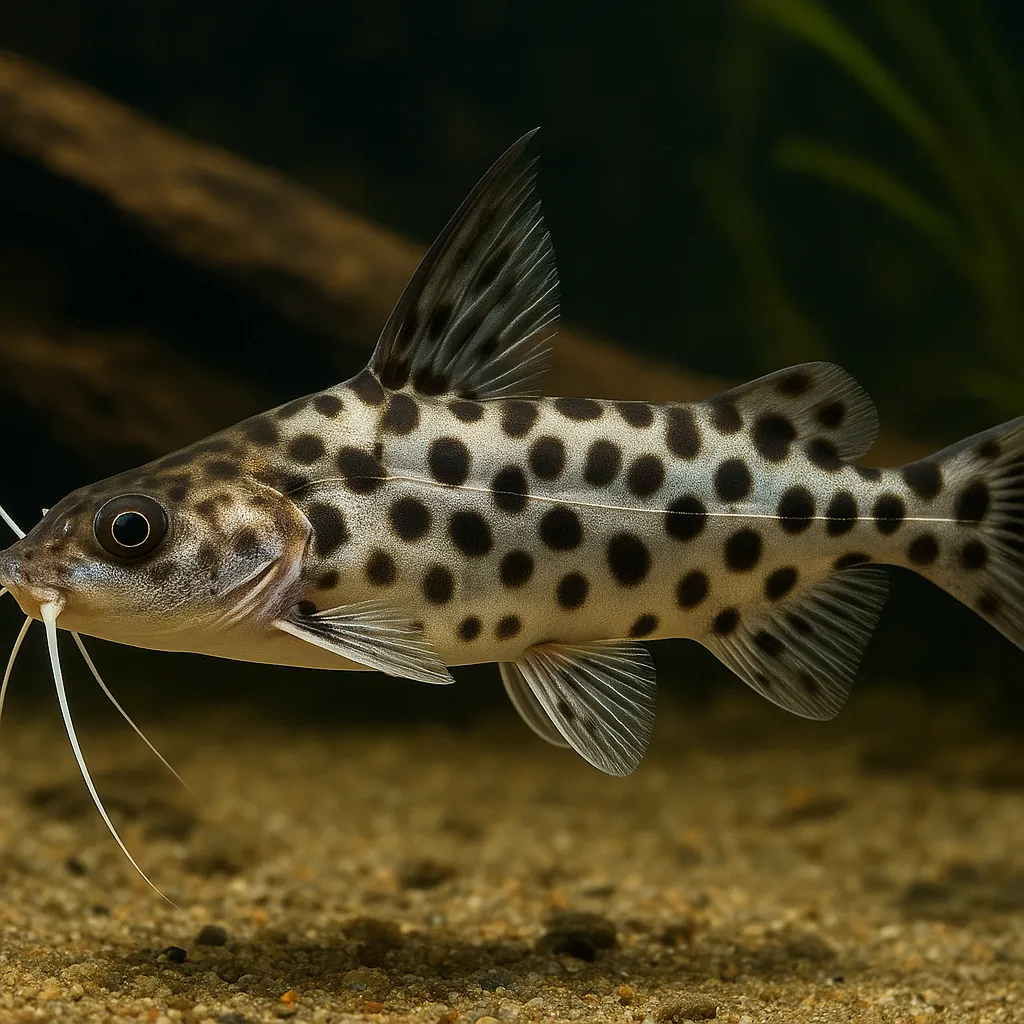
Pictus catfish
Introduction
The Pictus catfish (Pimelodus pictus), also known as the Painted catfish, is a popular choice among aquarists due to its striking appearance and lively behavior. Characterized by a sleek silver body adorned with black spots and long, flowing barbels, this species adds dynamic movement to any freshwater aquarium. While generally considered suitable for beginner to intermediate fishkeepers, the Pictus catfish does have specific care requirements that enthusiasts should be aware of to ensure its well-being.
What makes the Pictus catfish a favorite among aquarists?
Its unique spotted pattern and active swimming behavior make it a visually appealing and engaging addition to community tanks.
Is the Pictus catfish suitable for novice fishkeepers?
Yes, with proper research and attention to its care needs, beginners can successfully keep Pictus catfish.
Does the Pictus catfish require any special care considerations?
Yes, they need ample swimming space, appropriate tank mates, and specific water conditions to thrive.
Care and Environment
Providing an optimal environment is crucial for the health and happiness of the Pictus catfish. Here’s a comprehensive guide to their care:
What is the minimum tank size for a Pictus catfish?
A minimum of 200 liters is recommended to accommodate their active nature and swimming needs.
What are the ideal water parameters for Pictus catfish?
They thrive in temperatures between 23°C and 27°C, with a pH range of 6.5 to 7.5, and water hardness between 4 to 18 dGH.
How should the tank be set up for Pictus catfish?
Use a sandy or fine gravel substrate to protect their sensitive barbels. Incorporate hiding spots with rocks, driftwood, and dense planting to mimic their natural habitat.
What type of filtration and lighting do Pictus catfish require?
Efficient filtration is essential to maintain water quality, as they are sensitive to poor conditions. Moderate lighting with some dim areas is preferred, aligning with their nocturnal tendencies.
What should be included in the Pictus catfish's diet?
They are omnivorous and should be fed a balanced diet of high-quality sinking pellets or wafers, supplemented with live or frozen foods like bloodworms, brine shrimp, and daphnia.
Are there any specific challenges in keeping Pictus catfish?
They are sensitive to water quality and can be prone to diseases like Ich if conditions deteriorate. Regular water changes and monitoring are essential.
Origin and Habitat
The Pictus catfish is native to the warm, slow-moving waters of the Amazon and Orinoco river basins in South America, including countries like Colombia, Brazil, Venezuela, and Peru. In the wild, they inhabit shallow waters with sandy or muddy substrates, often surrounded by dense vegetation. These environments provide ample hiding spots and a steady flow, conditions that should be replicated in captivity to ensure their well-being.
Where are Pictus catfish originally from?
They originate from the Amazon and Orinoco river basins in South America.
What type of natural habitats do Pictus catfish prefer?
They favor shallow, slow-moving waters with sandy or muddy bottoms and abundant vegetation.
Why is it important to mimic their natural habitat in an aquarium?
Replicating their natural environment helps reduce stress and promotes natural behaviors, contributing to their overall health.
Temperament and Compatibility
Pictus catfish are known for their peaceful and social nature, making them suitable for community tanks. They are active swimmers and prefer to be kept in groups of three or more to encourage natural behavior and reduce stress. However, due to their predatory instincts, they may consume smaller fish that can fit into their mouths. Therefore, it's advisable to house them with similarly sized or larger peaceful species.
Are Pictus catfish aggressive?
No, they are generally peaceful but may eat smaller fish that fit into their mouths.
Do Pictus catfish prefer to be kept alone or in groups?
They are social and thrive when kept in groups of three or more.
What are suitable tank mates for Pictus catfish?
Compatible tank mates include medium to large-sized peaceful fish like tetras, barbs, gouramis, and other catfish species.
Interesting Facts
The Pictus catfish possesses several intriguing traits that make it a fascinating addition to aquariums. Their long barbels are highly sensitive and aid in navigating murky waters and locating food. These fish are also known for their rapid swimming abilities, requiring ample space to accommodate their activity levels. Additionally, when disturbed, Pictus catfish may produce a squeaking noise, a unique behavior among aquarium fish.
What unique feature helps Pictus catfish navigate their environment?
Their long, sensitive barbels assist in detecting food and navigating surroundings.
Why do Pictus catfish require spacious tanks?
They are rapid swimmers and need ample space to exhibit natural behaviors.
Can Pictus catfish produce sounds?
Yes, they can emit a squeaking noise when disturbed, which is audible outside the tank.
Sources
All information in this article has been gathered from the following reputable sources:
Overview
Recommended Tank Size 79.3 Gallons (for groups of 3 or more) |
Minimum Group Size 3 |
Minimum Tank Volume 52.8 Gallons |
Maximum Adult Length 4.7 inches |
Average Adult Length 3.9 inches |
Shoaling (6+ required) Yes |
Preferred Water Type Freshwater, soft to moderately hard, slightly acidic to neutral |
Temperature Range (°C) 23–27 |
pH Range 6.5–7.5 |
Water Hardness (dGH) 4–18 |
Typical Lifespan (years) 8 years |